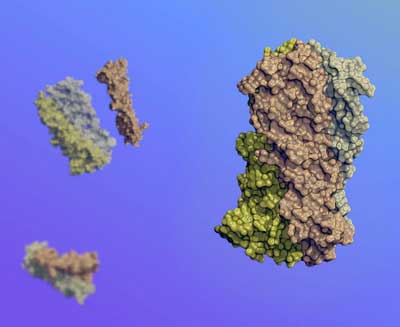| May 16, 2019 | |
Designing biological movement on the nanometer scale(Nanowerk News) Synthetic proteins have been created that move in response to their environment in predictable and tunable ways. These motile molecules were designed from scratch on computers, then produced inside living cells. |
|
| To function, natural proteins often shift their shapes in precise ways. For example, the blood protein hemoglobin must flex as it binds to and releases a molecule of oxygen. Achieving similar molecular movement by design, however, has been a long-standing challenge. | |
| An article in Science ("De novo design of tunable, pH-driven conformational changes") reports the successful design of molecules that change shape in response to pH changes. (pH is a chemical scale from basic to acidic.) | |
| The Institute for Protein Design at the University of Washington School of Medicine led the multi-institutional research. | |
| The researchers set out to create synthetic proteins that self-assemble into designed configurations at neutral pH and quickly disassemble in the presence of acid. | |
 |
|
| This is molecular art depicting the new proteins that can move in predictable, tunable ways in response to their environment. The proteins were designed from scratch on computers, then produced in living cells. (Image: Ian Haydon/Institute for Protein Design) | |
| The results showed that these dynamic proteins move as intended and can use their pH-dependent movement to disrupt lipid membranes, including those on the endosome, an important compartment inside cells. | |
| This membrane-disruptive ability could be useful in improving drug action. Bulky drug molecules delivered to cells often get lodged in endosomes. Stuck there, they can't carry out their intended therapeutic effect. | |
| The acidity of endosomes differs from the rest of the cell. This pH difference acts as a signal that triggers the movement of the design molecules, thereby enabling them to disrupt the endosome membrane. | |
| "The ability to design synthetic proteins that move in predictable ways is going to enable a new wave of molecular medicines," said senior author David Baker, professor of biochemistry at the UW School of Medicine and director of the Institute for Protein Design. "Because these molecules can permeabilize endosomes, they have great promise as new tools for drug delivery." | |
| Scientists have long sought to engineer endosomal escape. | |
| "Disrupting membranes can be toxic, so it's important that these proteins activate only under the right conditions and at the right time, once they're inside the endosome," said Scott Boyken, a recent postdoctoral fellow in the Baker lab and lead author on the recent project. | |
| Boyken achieved molecular motion in his designer proteins by incorporating a chemical called histidine. In neutral (neither basic nor acidic) conditions, histidine carries no electric charge. In the presence of a small amount of acid, it picks up positive charge. This stops it from participating in certain chemical interactions. This chemical property of histidine allowed the team to create protein assemblies that fall apart in the presence of acid. | |
| "Designing new proteins with moving parts has been a long-term goal of my postdoctoral work. Because we designed these proteins from scratch, we were able to control the exact number and location of the histidines," said Boyken. "This let us tune the proteins to fall apart at different levels of acidity." | |
| Other scientists from the UW, The Ohio State University, Lawrence Berkeley National Laboratory, and Howard Hughes Medical Institute's Janelia Research Campus contributed to this research. | |
| Those in Vicki Wysocki's Group at OSU used native mass spectrometry to determine the amount of acid needed to cause disassembly of the proteins. They confirmed the design hypothesis that having more histidines at interfaces between the proteins would cause the assemblies to collapse more suddenly. | |
| Collaborators in the Kelly Lee lab at the UW School of Pharmacy showed that the designer proteins disrupt artificial membranes in a pH-dependent manner that mirrors the behavior of natural membrane fusion proteins. | |
| Follow-up experiments conducted in Jennifer Lippincott-Schwartz's lab at HHMI's Janelia Research Campus showed that the proteins also disrupt endosomal membranes in mammalian cells. | |
| Re-engineered viruses that can escape endosomes are the most commonly used drug delivery vehicles, but viruses have limitations and downsides. The researchers believe a drug delivery system made only of designer proteins could rival the efficiency of viral delivery without the inherent drawbacks. |
| Source: University of Washington Health Sciences | |
|
Subscribe to a free copy of one of our daily Nanowerk Newsletter Email Digests with a compilation of all of the day's news. |
